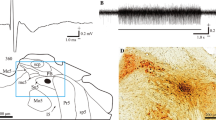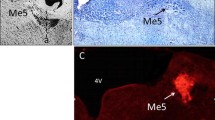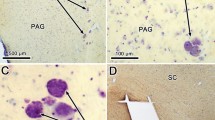Summary
-
1.
Intracellular responses in forelimb motoneurons to electrical stimulation of the whole labyrinth and of individual semicircular canal nerves were studied in decerebrated, unanesthetized cats.
-
2.
Stimulation of the whole labyrinth typically produced EPSPs, usually bilaterally, in forelimb extensor (LON, LAT, MED) and shoulder (SI) motoneurons and bilateral IPSPs in forelimb flexor (BIC) motoneurons.
-
3.
Latencies of PSPs indicated that most of those in extensor motoneurons were trisynaptic and many seen in flexor motoneurons may involve four synapses.
-
4.
In the cells sampled, stimulation of the anterior, horizontal or posterior canal nerves often evoked EPSPs in extensor and IPSPs in flexor motoneurons, both ipsi-and contralaterally. Responses to canal stimulation were weaker and more variable than those to stimulation of the whole nerve.
-
5.
Transection of the MLF in the lower medulla had no effect on PSPs evoked in forelimb motoneurons. Lesions in the medulla in the area of the LVST greatly reduced the occurrence of contralateral EPSPs in extensor and IPSPs in flexor motoneurons. The pathway linking labyrinths to forelimb motoneurons therefore appears to include the LVST. Hemisection shows that the pathway to contralateral motoneurons descends in the cord on the side of the stimulated labyrinth before crossing to influence these cells.
-
6.
Labyrinthine control of forelimb motoneurons is less direct than control of neck and back motoneurons. It is suggested that the interneuron in the pathway to forelimb motoneurons is the site of integration of labyrinthine with other reflexes.
Similar content being viewed by others
References
Akaike, T., Fanardjian, V.V., Ito, M., Ohno, T.: Electrophysiological analysis of the vestibulo spinal reflex pathway of rabbit. II. Synaptic actions upon spinal neurons. Exp. Brain Res. 17, 497–515 (1973)
Aoyama, M., Hongo, T., Kudo, N., Tanaka, R.: Convergent effects from bilateral vestibulospinal tracts on spinal interneurons. Brain Res. 35, 250–253 (1971)
Batini, C., Moruzzi, G., Pompeiano, O.: Cerebellar release phenomena. Arch. ital. Biol. 95, 71–95 (1957)
Berthoz, A., Anderson, J.H.: Frequency analysis of vestibular influence on extensor motoneu rons. I. Response to tilt in forelimb extensors. Brain Res. 34, 370–375 (1971)
Bruggencate, G. ten, Lundberg, A.: Facilitatory interaction in transmission to motoneurones from vestibulospinal fibres and contralateral primary afferents. Exp. Brain Res. 19, 248–270 (1974)
Cohen, B., Suzuki, J.-I., Bender, M.B.: Eye movements from semicircular canal nerve stimulation in the cat. Ann. Otol. (St. Louis) 73, 153–169 (1964)
Duensing, F., Schaefer, K.P.: Über die Konvergenz verschiedener labyrinthärer Afferenzen auf einzelne Neurone des Vestibulariskerngebietes. Arch. Psychiat. Nervenkr. 199, 345–371 (1959)
Eccles, J.C.: The Physiology of Synapses. Berlin-Göttingen-Heidelberg-New York: Springer 1964
Eccles, J.C., Eccles, R.M., Lundberg, A.: The convergence of monosynaptic excitatory afferents on to many different species of alpha motoneurones. J. Physiol. (Lond.) 137, 22–50 (1957)
Flock, Å.: Structure of the macula utriculi with special reference to directional interplay of sensory responses as revealed by morphological polarization. J. Cell Biol. 22, 413–431 (1964)
Gernandt, B.E., Ades, H.W.: Spinal motor responses to acoustic stimulation. Exp. Neurol. 10, 52–66 (1964)
Gernandt, B.E., Gilman, S.: Descending vestibular activity and its modulation by proprio ceptive, cerebellar and reticular influences. Exp. Neurol. 1, 274–304 (1959)
Grillner, S., Hongo, T., Lund, S.: The vestibulospinal tract. Effects on alpha motoneurons in the lumbosacral spinal cord in the cat. Exp. Brain Res. 10, 94–120 (1970)
Hongo, T., Kudo, N., Tanaka, R.: Effects from the vestibulospinal tract on the contralateral hindlimb motoneurones in the cat. Brain Res. 31, 220–223 (1971)
de Kleijn, A., Magnus, R.: Über die Funktion der Otolithen. I. Mitteilung. Otolithenstand bei den tonischen Labyrinthreflexen. Pflügers Arch. ges. Physiol. 186, 6–38 (1921)
Klüver, H., Barrera, E.: A method for the combined staining of cells and fibers in the nervous system. J. Neuropath. exp. Neurol. 12, 400–403 (1953)
Lindeman, H.H.: Studies on the morphology of the sensory regions of the vestibular appara tus. Ergebn. Anat. 42, 7–110 (1969)
Lund, S., Pompeiano, O.: Monosynaptic excitation of alpha motoneurones from supraspinal structures in the cat. Acta physiol. scand. 73, 1–21 (1968)
Magherini, P.C., Precht, W., Richter, A.: Vestibulospinal effects on hindlimb motoneurons of the frog. Pflügers Arch. 348, 211–223 (1974)
Magnus, R.: Some results of studies in the physiology of posture. Lancet 211, 531–536, 585–588 (1926)
Maunz, R.A., Maeda, M., Wilson, V.J.: Labyrinthine control of cat forelimb motoneurons. 4th Ann. Meeting Soc. Neurosci. 328 (1974)
Peterson, B.W.: Distribution of neural responses to tilting within vestibular nuclei of the cat. J. Neurophysiol. 33, 750–767 (1970)
Peterson, B.W., Felpel, L.P.: Excitation and inhibition of reticulospinal neurons by vestibular, cortical and cutaneous stimulation. Brain Res. 27, 373–376 (1971)
Petras, J.M.: Cortical, tectal and tegmental fiber connections in the spinal cord of the cat. Brain Res. 6, 275–324 (1967)
Rall, W., Burke, R.E., Smith, T.G., Nelson, P.G., Frank, K.: Dendritic location of synapses and possible mechanisms for the monosynaptic EPSP in motoneurons. J. Neurophysiol. 30, 1169–1193 (1967)
Reighard, J., Jennings, H.S.: Anatomy of the cat (3d ed.). New York: Holt 1935
Reinoso-Suarez, F.: Topographischer Hirnatlas der Katze. Darmstadt: Merck 1961
Roberts, T.D.M.: Neurophysiology of Postural Mechanisms. London: Butterworths 1967
Roberts, T.D.M.: Changes in stretch reflexes in limb extensor muscles during position reflexes from the labyrinth in the cat. J. Physiol. (Lond.) 211, 45P (1970)
Rosenberg, J.R., Lindsay, K.W.: Asymmetric tonic labyrinthine reflexes. Brain Res. 63, 347–350 (1973)
Sherrington, C.S.: Flexion-reflex of the limb, crossed extension-reflex, and reflex stepping and standing. J. Physiol. (Lond.) 40, 28–121 (1910)
Shimazu, H., Precht, W.: Tonic and kinetic responses of cat's vestibular neurons to horizontal angular acceleration. J. Neurophysiol. 28, 991–1013 (1965)
Sterling, P., Kuypers, H.G.J.M.: Anatomical organization of the brachial spinal cord of the cat. III. The propriospinal connections. Brain Res. 7, 419–443 (1968)
Suzuki, J.-I., Cohen, B.: Head, eye, body and limb movements from semicircular canal nerves. Exp. Neurol. 10, 393–405 (1964)
Suzuki, J.-I., Goto, K., Tokumasu, K., Cohen, B.: Implantation of electrodes near individual vestibular nerve branches in mammals. Ann. Otol. (St. Louis) 78, 815–826 (1969)
Szentágothai, J.: Die Rolle der Einzelnen Labyrinthrezeptoren bei der Orientation von Augen und Kopf im Raume. Budapest: Akademiai Kiado 1952
Wilson, V.J.: Physiological pathways through the vestibular nuclei. Int. Rev. Neurobiol. 15, 27–81 (1972)
Wilson, V.J., Felpel, L.P.: Specificity of semicircular canal input to neurons in the pigeon vestibular nuclei. J. Neurophysiol. 35, 253–264 (1972)
Wilson, V.J., Kato, M., Peterson, B.W., Wylie, R.M.: A single-unit analysis of the organiza tion of Deiters' nucleus. J. Neurophysiol. 30, 603–619 (1967)
Wilson, V.J., Maeda, M.: Connections between semicircular canals and neck motoneurons in the cat. J. Neurophysiol. 37, 346–357 (1974)
Wilson, V.J., Wylie, R.M., Marco, L.A.: Synaptic inputs to cells in the medial vestibular nucleus. J. Neurophysiol. 31, 176–186 (1968)
Wilson, V.J., Yoshida, M.: Comparison of effects of stimulation of Deiters' nucleus and medial longitudinal fasciculus on neck, forelimb, and hindlimb motoneurons. J. Neurophysiol. 32, 743–758 (1969a)
Wilson, V.J., Yoshida, M.: Monosynaptic inhibition of neck motoneurons by the medial vestibular nucleus. Exp. Brain Res. 9, 365–380 (1969b)
Wilson, V.J., Yoshida, M., Schor, R.H.: Supraspinal monosynaptic excitation and inhibition of thoracic back motoneurons. Exp. Brain Res. 11, 282–295 (1970)
Author information
Authors and Affiliations
Additional information
Supported in part by N.I.H. grants NS 02619 and NS 05463.
Recipient of N.I.H. Fellowship 1 F02 NS 55199.
Rights and permissions
About this article
Cite this article
Maeda, M., Maunz, R.A. & Wilson, V.J. Labyrinthine influence on cat forelimb motoneurons. Exp Brain Res 22, 69–86 (1975). https://doi.org/10.1007/BF00235412
Received:
Issue Date:
DOI: https://doi.org/10.1007/BF00235412




